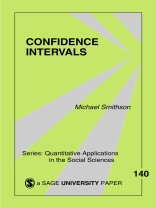Smithson first introduces the basis of the confidence interval framework and then provides the criteria for ‚best‘ confidence intervals, along with the trade-offs between confidence and precision. Next, using a reader-friendly style with lots of worked out examples from various disciplines, he covers such pertinent topics as: the transformation principle whereby a confidence interval for a parameter may be used to construct an interval for any monotonic transformation of that parameter; confidence intervals on distributions whose shape changes with the value of the parameter being estimated; and, the relationship between confidence interval and significance testing frameworks, particularly regarding power.
Inhaltsverzeichnis
Ch 1 Introduction and Overview
Ch 2 Confidence Statements and Interval Estimates
Why Confidence Intervals?
Ch 3 Central Confidence Intervals
Central and Standardizable versus Noncentral Distributions
Confidence Intervals Using the Central t and Normal Distributions
Confidence Intervals Using the Central Chi-Square and F Distributions
Transformation Principle
Ch 4 Noncentral Confidence Intervals for Standardized Effect Sizes
Noncentral Distributions
Computing Noncentral Confidence Intervals
Ch 5 Applications in Anova and Regression
Fixed-Effects ANOVA
Random-Effects ANOVA
A Priori and Post-Hoc Contrasts
Regression: Multiple, Partial, and Semi-Partial Correlations
Effect-Size Statistics for MANOVA and Setwise Regression
Confidence Interval for a Regression Coefficient
Goodness of Fit Indices in Structural Equations Models
Ch 6 Applications in Categorical Data Analysis
Odds Ratio, Difference between Proportions and Relative Risk
Chi-Square Confidence Intervals for One Variable
Two-Way Contingency Tables
Effects in Log-Linear and Logistic Regression Models
Ch 7 Significance Tests and Power Analysis
Significance Tests and Model Comparison
Power and Precision
Designing Studies Using Power Analysis and Confidence Intervals
Confidence Intervals for Power
Concluding Remarks
References
About the Author
Über den Autor
Michael Smithson is a Professor in the Research School of Psychology at The Australian National University in Canberra, and received his Ph D from the University of Oregon. He is the author of Confidence Intervals (2003), Statistics with Confidence (2000), Ignorance and Uncertainty (1989), and Fuzzy Set Analysis for the Behavioral and Social Sciences (1987), co-author of Fuzzy Set Theory: Applications in the Social Sciences (2006) and Generalized Linear Models for Categorical and Limited Dependent Variables (2014), and co-editor of Uncertainty and Risk: Multidisciplinary Perspectives (2008) and Resolving Social Dilemmas: Dynamic, Structural, and Intergroup Aspects (1999). His other publications include more than 170 refereed journal articles and book chapters. His primary research interests are in judgment and decision making under ignorance and uncertainty, statistical methods for the social sciences, and applications of fuzzy set theory to the social sciences.












